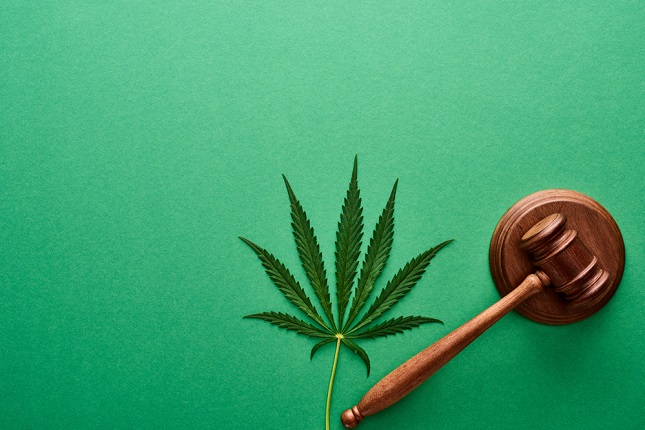U.S., September 3, 2019 (GREEN MARKET REPORT)- “Is the United States on the verge of federal marijuana legalization?
Ready or not, marijuana legalization is on the verge of happening nationwide. Or so they say.
Although Congress really hasn’t made much progress on the issue of cannabis reform in the past nine months, some federal lawmakers still insist that the nation is close to tearing down the walls of marijuana prohibition in the United States, potentially before the end of the year.
From where I am sitting, however, it seems highly unlikely that the same grey-haired Congress that hasn’t yet managed to pull it together on a simple banking bill is all of a sudden going to rise up and legalize the leaf nationwide as its Christmas gift to the nation.
Sure, the SAFE Banking Act has a heck of a lot of sponsors in the House of Representatives — and more Republican support than you might imagine — but there is still no sign that Senate leadership, a crucial component to all of this bill passing business, is prepared to embrace any pot-related legislation.
As far as we know, Senate Majority Leader Mitch McConnell still isn’t willing to make even the slightest move toward legal weed; however, there have been some wicked, unforeseen developments.
When Mitch McConnell made it his mission last year to legalize industrial hemp in the United States for the first time since 1937, he probably didn’t think for a second that it was going to inadvertently lead to marijuana legalization. But ending pot prohibition at the federal level might be the only way out of the conundrum that he has created.
You see, law enforcement can’t seem to distinguish between legal hemp and marijuana. After all these decades, the cops still don’t have the technology to tell the difference between the two plants. And that spells trouble.“
It is already causing a slew of problems in states across the nation. Here are three of the most pressing matters that might give Congress absolutely no choice but to surrender to marijuana legalization in the interest of public health and safety.
- Reason #1: Police confused on how to distinguish the difference between hemp and marijuana.
In Hemp vs. Marijuana, the Law Enforcement Community is in a State of Confusion Over What Is Hemp and What Is Marijuana But these are high stakes, no pun intended.
What’s the difference between hemp and marijuana? Megan Mittelhammer examined the issue on August 22, 2019:
You might not think there’s a reason to know the distinction between the two leafy green plants, but a new Georgia hemp law just made it a little more important in the state. Marijuana is still not legal in the state, but law enforcement cannot accurately tell the difference between the substances right now. But, what really is the difference between hemp and marijuana?
The science: Marijuana and hemp come from the Cannabis plant but are different variations. Marijuana contains higher amounts of psychoactive THC and can be used for recreational or medicinal purposes, according to the National Center for Biotechnology Information. Hemp, on the other hand, contains 0.3% or less THC, meaning it doesn’t cause the same psychoactive effects. Hemp can be used in health foods, cosmetics and textiles.
Both hemp and marijuana can be used to create CBD extracts, but hemp has a higher concentration of the compound. CBD does not create the same high as THC and can be used for chronic pain and anxiety relief, according to Harvard Medical School. Both hemp and marijuana have extreme physical similarities.
The politics: It’s a confusing time for cannabis-users in the United States. It seems like every state has different regulations on the plant, and Georgia now has stark distinctions between marijuana and hemp. The 2018 Farm Act made hemp production and distribution legal on a federal level and left up to the states for regulation.”
The Associated Press also warned the public back in March 2019 that Legal hemp, pot’s look-alike, creates confusion for police.
However, this is not a new debate. Back on June 4, 2018, in honor of Hemp History Week, Jessica Walters at CannaMD explored the background of “marijuana’s controversial cannabis brother, hemp – a non-psychoactive variety of the cannabis plant, cannabis sativa.” The fact that distinguishing CBD from Marijuana Poses Current Challenges for Law Enforcement is a conundrum.
On September 10, 2019, Marijuana Business Daily highlighted one ambitious anti-cannabis governor targeted hemp, saying plant too close for police:
A Republican governor who strongly opposes cannabis legalization says that allowing hemp cultivation is just as problematic. South Dakota Gov. Kristi Noem took her argument national in The Wall Street Journal, arguing in an op-ed column that law enforcement doesn’t have the testing capacity to discern between marijuana and legal hemp, which has no more than 0.3% THC.”
- Reason #2: Fake Cannabis Vapes Leading To Health Epidemic. Fake vapes could force the federal government to change marijuana laws.
In an additional report by Mike Adams in Forbes, he accurately states that “People all across the United States are developing potentially life-threatening lung issues as a result of using marijuana vaporizers. There have been hundreds of cases reported nationwide where vape users have been admitted to Intensive Care Units of local hospitals for pneumonia-like respiratory infections. At the time that this article was written, there has been at least one death connected to this scourge. This health problem is a direct result of federal cannabis prohibition.
Just like the days when alcohol was outlawed in the United States, back when thousands of people died every year as a result of tainted liquor produced in the underground, black market criminal organizations are counterfeiting popular cannabis brands.
These knock offs are being sold all over the country — the only way to curb (or stop) this sort of thing from happening is to end marijuana prohibition at the federal level and allow weed to be taxed and regulated like tobacco and alcohol. It is conflicting state and federal law that has allowed the black market to swell into the monster that it has become.
So, if fake cannabis vapes end up spawning a vicious health epidemic that puts more Americans at risk of life threatening health issues, that might be enough to inspire the federal government to make a change. Let’s just hope that something happens, though, before more people end up sick or dead.”
CDC Says Number Of Possible Cases Of Vaping-Related Lung Illness Has Doubled, reported Joe Neel. While Vaping-Related Lung Disease Prompts Public Health Questions Across Cannabis Industry pointed out that:
With five vaping-related deaths leading national headlines, the industry examines hypotheses about this rash of illnesses. The perplexing narrative of vaping-related lung illnesses escalated into a full-blown national media frenzy last week with news that a fifth person had died from alarming pulmonary symptoms. While not every case of this mysterious disease is linked to concentrated cannabinoid cartridges (or even products sold in legal state cannabis markets), the question of what, precisely, is causing vaping technology to harm individuals has captured the American consumer’s attention.”
New York State Department of Health issued a warning against illicit-market vape products on September 6, 2019, including various branded cartridges obtained across the U.S. in recent years.
The state’s health officials pointed specifically to vitamin E acetate as a potential culprit. Even as the department was publishing its health advisory, a third death, this time in Indiana, was linked to vaping products; by the weekend, the death count had risen to five. The Centers for Disease Control and Prevention (CDC) reported more than 450 other cases of vaping-related illnesses in 33 states.”
The dark-blue shading on this map represents U.S. states that have reported cases resembling the vaping-related lung disease. While health officials are targeting all vape products and technologies, the cannabis industry has its own vaping-related concerns alongside the tobacco industry.
A 2017 study published in ACS Omega by Jiries Meehan-Atrash, Wentai Luo and Robert M. Strongin from Oregon State University, titled “Toxicant Formation in Dabbing,” found ‘issues with terpene concentration in cannabis extracts and nicotine cartridges.’”
The national debate about vape cartridge and vaporizers is not new. Three months ago, Kenneth Morrow’s June 18, 2019 article What’s in Your Vape Cartridge.
Five months ago on April 5, 2019, Justine Griffin examined the vital cannabis question If smoking is bad, how can smoking medical marijuana be good? We asked doctors:
While smoking medical marijuana is touted for its health benefits, smoking still comes with risks. Doctors say they look forward to seeing more research on the subject as more states allow marijuana in smokable form.
When Gov. Ron DeSantis and the Legislature made it legal last month to smoke medical marijuana, they did it in the name of better health — the idea that thousands of Floridians would gain relief from a variety of illnesses. Yet it seemed to run counter to everything modern medicine says about smoking. Isn’t it really bad for you?
Physicians say yes: Smoking anything, be it tobacco or cannabis, comes with some risk. But the answer is more complicated”
Bottom lines:
- Smoking and vaping both cause health concerns.
- Law enforcement is confused about cannabis and hemp products.
Meanwhile, in addition to the FDLE, both the Boards of Allopathic and Osteopathic Medicine need to be more heavily involved in this medical marijuana conversation, both on the national and state levels.
But in addition to the two reasons mentioned above, I would argue that there is a third, vitally important reason that will force marijuana reform at a federal level.
- Reason #3: Physicians-in-training are not prepared to prescribe medical marijuana. Therefore, a small number of Florida doctors are approving thousands of medical marijuana patients in Florida.
In November 2017, Drug and Alcohol Dependence, warned:
With even more states on the cusp of legalizing medical marijuana, physician training should adapt to encompass this new reality of medical practice. iui(1) While most physicians-in-training think education about medical marijuana should be required; (2) only 9% of medical schools have medical marijuana documented in their curriculum; and (3) education can improve physician preparedness to prescribe medical marijuana.”
How can we improve awareness of cannabis as a medicine within the medical community? The Society of Cannabis Clinicians offers the insightful Educating Healthcare Professionals About the Medical Use of Cannabis.
But right now, the state and national medical boards are not part of this vital cannabis conversation at all, and Florida recently discovered the abysmal fact that Just 89 doctors certify 94,850 Florida medical marijuana patients, report finds, as reported by Christine Sexton on September 3, 2019:
As the number of Floridians allowed to use medical marijuana continues to grow, new numbers show that a relative handful of doctors have been responsible for a majority of the patients approved for pot. Florida had 168,810 patient ‘certifications’ for medical marijuana between Oct. 1 and March 31, and more than half of them came from 89 doctors, according to a new draft state report on medical marijuana.
The report has alarmed members of a special panel of doctors charged with keeping tabs on the ordering patterns of physicians who can authorize patients to take medical marijuana. Panel members fear that if left unabated, medical marijuana will become the state’s next public-health problem.
Although members of the Physician Certification Pattern Review Panel of the Board of Medicine and the Board of Osteopathic Medicine were hazy about what sort of recommendations they should submit, with concerns stemmed from data showing that 1,207 physicians had active medical-marijuana certifications during the six-month review period, but just 89 of them were responsible for 94,850 of certifications. Put another way, 7 percent of the physicians were responsible for 56 percent of the medical marijuana certifications.”
Larry Dobrow closely examines this cannabis educational void in his September 16, 2019 article, Everyone says they know cannabis, but most professionals need an education: “For all the talk about how cannabis will transform the worlds of health and wellness, one impediment stands in the way of its ascendance: an education gap. Marketers and entrepreneurs of all stripes want to hop on the cannabis bandwagon as soon as possible, but many of them don’t know what they don’t know.”
This presents a highly problematic situation because Medical marijuana markets expanding at varying rates, with Oklahoma, Florida setting the pace as explained by Maggie Cowee on August 13, 2019:
While medical marijuana is legally available in 36 states and Washington DC, the fragmented nature of the industry – each state creates its own set of rules – means each market grows at a different rate. The new quarterly release of the Marijuana Business Factbook presents updated profiles of each state market, highlighting the growth occurring in each. An analysis of state markets that release patient counts on at least a quarterly basis reveals several key takeaways.
Namely that Florida is the second-fastest-growing market in terms of patients joining the registry, with registered patients making up 1.6% of the state’s total population. This leaves room for further growth, which may occur from the recent legalization of smokable flower and continued wide access to dispensaries.”
In October 2018, the U.S. showed a Record-High Number Of Americans Support Legalizing Marijuana, as reported by Lydia O’Connor, with 66% supporting legal weed. That’s roughly two-thirds of Americans, marking a record-high approval rate and a stance more and more Americans have taken this stance since 2000, when only 31% endorsed legalization, finding that:
Legal weed is now supported by a majority of Americans across various demographics. The record-high support comes in spite of the federal illegality.”
Additionally, Marijuana Policy Project’s resources on Medical Marijuana indicate that: “Because Congress and the DEA have failed to make medical cannabis legal — despite ample evidence of its safety and efficacy —polls consistently show that states have enacted their own laws to protect patients.”
 Investment value finders Investment value finders
Investment value finders Investment value finders




